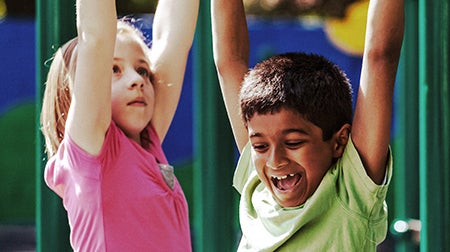Whether jumping through sprinklers at city parks, chasing soccer balls at camp, or kayaking with family, the quintessential childhood summer is filled with physical activity. Fortunately, summer programming has often reflected that kids need to get outdoors, use their bodies, play, and socialize. What’s troubling is what happens during the other 10 months of the year, when kids are put behind desks for between six and seven hours each day. I often wonder: What do schools have against using the body during the school day?
Throughout the last few decades, I’ve traveled the country with The PEAR Institute to partner with numerous schools and districts. What I’ve noticed is that schools just aren’t cutting it when it comes to giving students time to move and be active. However, the public health community is clear in its assessment that schools must play a role in childhood physical activity. For youth, engaging in physical activity is particularly important, as a lack of exercise is seen as a predictor of complications later in life; it plays a role in cardiovascular disease, muscle and bone health, obesity, and brain health. As a result, the CDC recommends that young people get at least 60 minutes of moderate-to-vigorous physical activity each day. However, only about 21 percent of young people in kindergarten through high school reach this target at least five days per week.

Unfortunately, schools face a serious challenge in trying to balance the concerns vocalized by health professionals, parents, and students themselves with the demand for academic success. Federal education policy and international comparisons have driven schools to focus heavily on “time on task,” which has led to extended school days and cuts to break times, including recess. In roughly 68 percent of schools, this single-minded focus on academics allows students to be excused from gym class in order to participate in additional instructional time, complete remedial work, or prepare for a test. Similarly, recess is often seen as a privilege; in some 54 percent of schools, staff are not prohibited or discouraged from excluding students from all or part of recess as punishment for bad behavior or failure to complete class work.
The argument has long been that with only so many hours in a day, schools must prioritize academics over physical and mental health. However, there is little evidence to support that cutting back activity breaks for exercise and play will promote learning. In fact, in a future post, I hope to go into detail about the benefits that breaks, like recess, can have on students’ academic performance. Until then, consider the frequently praised Finnish educational system. In Finland, the basic model for K-12 education is 45 minutes of instructional time followed by a 15-minute break. Still, the most recent Program for International Student Assessment data shows Finland far out-performing the US academically.
Physical, social, and emotional well-being are major components in both classroom learning and all 21st-century careers. For this reason, it has long mystified me that schools might see any benefit in limiting physical activity throughout the day. While schools and districts extend the school year and school day, they should take note of summer and afterschool learning programs that have long been able to balance learning and moving to keep youth engaged and healthy. I hope that when students go back to school in the next few weeks they are not jolted out of their active lives. Students must be supported to develop healthy practices for their minds and bodies all year. Only then will schools be able to say they are teaching the whole child.
Gil G. Noam, EdD, is the founder and director of The PEAR Institute: Partnerships in Education and Resilience at McLean Hospital and Harvard Medical School.
Read more about Dr. Gil Noam and The PEAR Institute’s efforts to support resilience amidst adversity and help families understand youth development.
